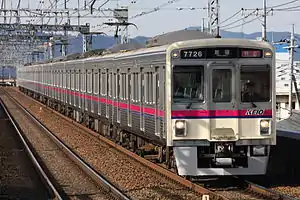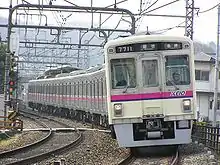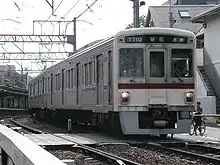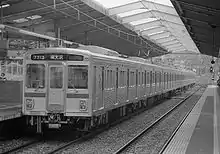Keio 7000 series
The Keio 7000 series (京王7000系) is a Japanese electric multiple unit (EMU) commuter train type operated by the private railway operator Keio Corporation on commuter services in the western suburbs of Tokyo.
| Keio 7000 series | |
|---|---|
 10-car 7000 series set | |
| Manufacturer | Nippon Sharyo, Tokyu Car Corporation |
| Constructed | 1984–1996 |
| Entered service | 1984 |
| Number built | 190 vehicles |
| Formation | 2/4/6/8/10 cars per trainset |
| Operator(s) | Keio Corporation |
| Specifications | |
| Car body construction | Stainless steel |
| Car length | 20 m (65 ft 7 in) |
| Doors | 4 pairs per side |
| Maximum speed | 110 km/h (70 mph) |
| Acceleration | 2.5 km/h/s |
| Deceleration | 4.0 km/h/s (4.5 km/h/s for emergency brake) |
| Electric system(s) | 1,500 V DC |
| Current collection method | Overhead |
| Track gauge | 1,372 mm (4 ft 6 in) Scotch Gauge |


Technical details
- Control system
- Original and 7701–7703: Chopper
- Refurbished (excluding 7701–7703): IGBT-VVVF
- 10-car sets (6 motored cars): Chopper
- 10-car sets (5 motored cars): VVVF
- 8-car sets (5 motored cars): Chopper
- 8-car sets (4 motored cars): VVVF
- 6-car sets (4 motored cars): Chopper
- 6-car sets (3 motored cars): VVVF
- 4-car sets (2 motored cars): Chopper
- 2-car sets (1 motored car): Chopper
- Motor output: 150 kilowatts (200 hp)
- Drive mechanism: Parallel cardan shaft
- Headlights: Sealed beam
- Destination indicators: roller blind
Body
The body is stainless steel. Early sets used corrugated panels, while sets made after 1987 had a beaten style. (Some corrugated-style cars were made after 1987 as middle cars for sets made early in production.) The sides were not painted. Fronts of early sets were the same color as the sides. The front designs are of two types, but the difference is minor.
Driver's cab
The driver's cab contains a "T"-shaped, one-handle master-controller system. The speedometer is analog, providing information up to 140 km/h (87 mph).
- Acceleration: 4 notch
- Deceleration: 7 notch + emergency
 Driver's cab
Driver's cab
Interior
Seating consists of longitudinal bench seats, arranged 4-7-7-7-4 in intermediate cars. Original sets have no passenger information displays, but refurbished sets feature 3-color LED information displays (four per car).
 Interior of car in original condition
Interior of car in original condition Inside of a refurbished car
Inside of a refurbished car Priority seats of car in original condition
Priority seats of car in original condition Priority seats of a refurbished car
Priority seats of a refurbished car LED passenger information display
LED passenger information display
Operations
Used on all Keio Corporation lines. (excluding Inokashira Line)
- For daytime operation, 10-car sets or 10-car trains of six-car sets coupled to four-car sets are used as Special Express and Semi Special Express trains.
- Eight-car sets or eight-car trains of six-car sets coupled to two-car sets are used mainly as Local or Rapid trains.
- Ten-car trains of eight-car sets coupled to two-car sets are used at rush hours.
History

The 7000 series began service in 1984. The 7000 series was built for local train service, and the first sets were five-car sets, rather than 4, 6 or 10 cars. The running performance of the new series was nearly the same as the Keio 6000 series. By 1996, 190 cars of the 7000 series had been built.
From 2001, 7000 series sets were introduced on Special Express, Semi Special Express, Express, and Rapid trains.
Keio announced in 2010 that 18 more of its 7000 series cars would be converted to VVVF inverter control.[1]
References
| Wikimedia Commons has media related to Keio 7000 series. |
- Investors' Guide 2010 Archived 22 July 2011 at the Wayback Machine Retrieved 19 December 2010. (in English)